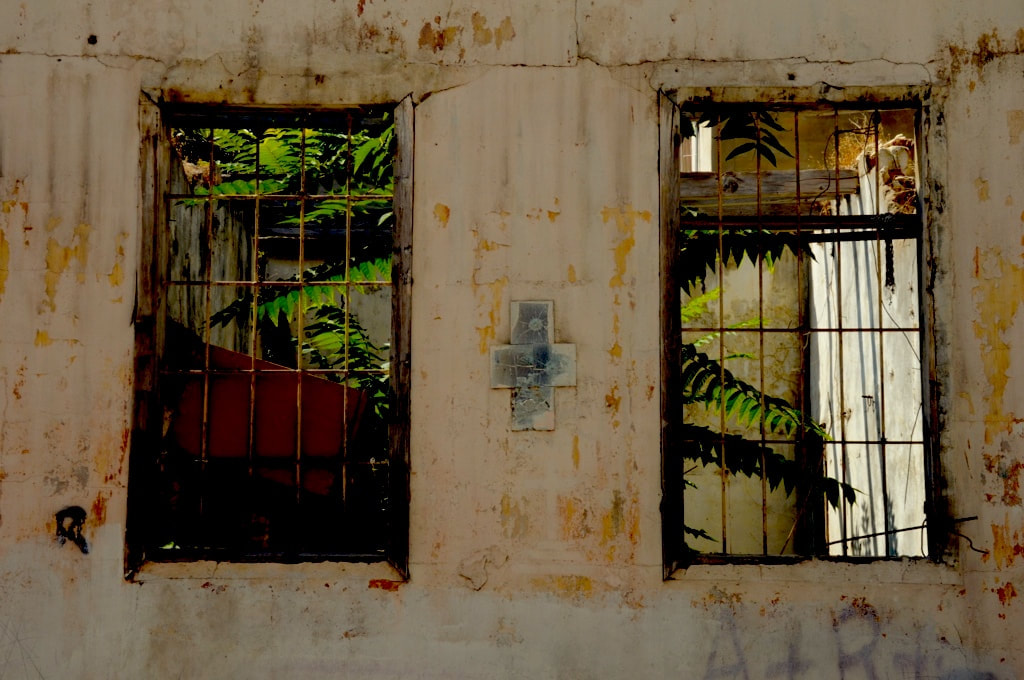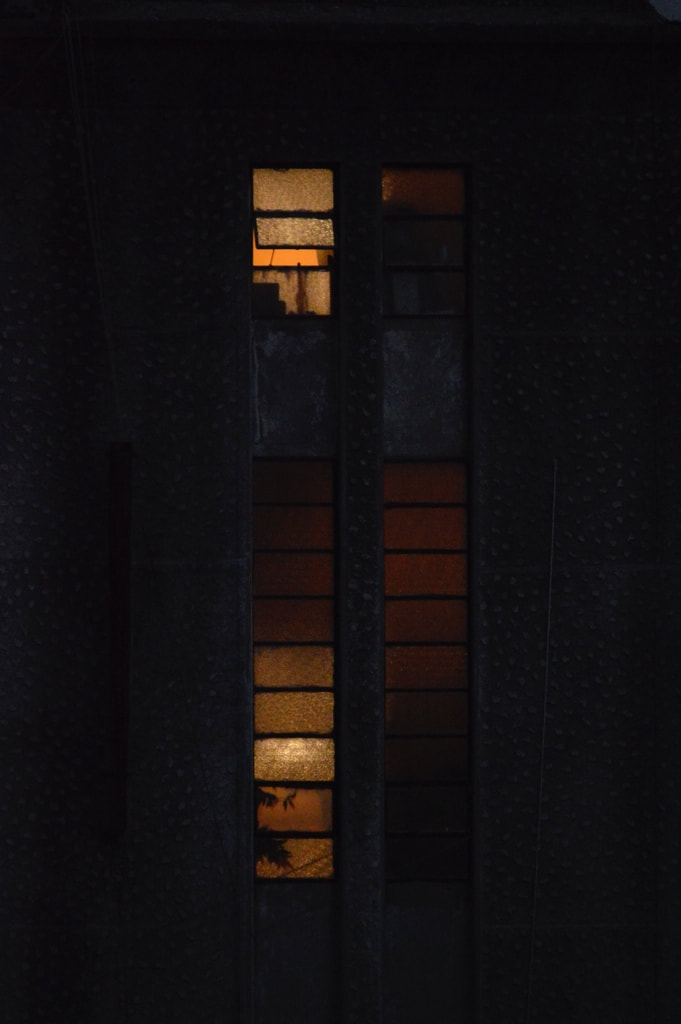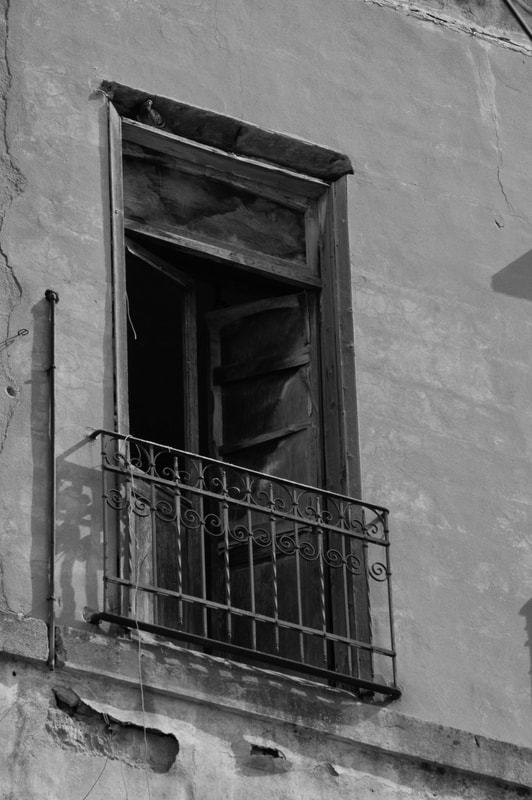Portals: The Interstices of Spaces
It looms, dark and forbidding, wide and inviting. What lurks inside? I can’t see beyond the gloom. No barrier repels my advance, no wire bars my way, yet there is a tacit understanding between us that I am not to enter. But despite this, I am pulled towards the gaping void, a siren call of the unknown and unknowable; curiosity compelling me, pushing me. I stand on the threshold, framed by its physicality; neither outside nor inside. I exist in the space in between. I am nowhere, but I am everywhere.
Doorways and windows obsess me. These portals, leading from the outside in, and the inside out; open, exposed, voids straddling the cusp. They welcome and repel. The delineation of spaces, existing in two worlds yet, in neither. They are gateways the thresholds of which we must pass on our constant journeys between the interior and exterior, and in doing so portals create a realm of their own, a realm of transition.
The gate writhes with wrought iron snakes which guard the secrets lying behind the closed green door. Glass frosted like ice. No trespassing. I can only look but cannot enter.
In mythology this otherness, this thing existing between two oppositional forces, has traditionally held great power. It is where the laws of physics cease to matter. Sunrise – sunset. Dawn – dusk. Both yet neither. All yet nothing. It is in this transcendental space that portals exist. Not only moving us between two states of being, but as a state of being themselves.
Wire wraps it, trying to bind the walls together to hide the wound. Yet the darkness behind peeps out; escaping, retreating. Windows boarded shut, only the door remains. Small gaps through which space passes, passes from one to the other, afraid to wait in the jagged embrace of iron barbs. I want to cut those bindings, break the darkness free so that I can feel it.
When portals exist in derelict buildings, their sense of existing in a transitional world is heightened. The boundaries between the interior and the exterior have physically disappeared, yet they still exist. Their role as entryways remains.
No traces remain of glass in the frame. Long disappeared, forever holding the sights its glassy eyes have seen secret. Wood, warped by weather, worn by time, still valiantly keeps the wall from claiming it as the algae covered concrete sags slowly to the ground. I am looking in…who once looked out? What did they see as they gazed through this window at the street below?
Decay is part of the natural order of cities. Eventually everything built will crumble, leaving only fragments, traces. As they fall back into the earth they are like ghosts, shadows of what they once were, holding the city’s soul in their stones and ashes.
Nature is reclaiming its ground here. Bushes push themselves through the urban soil and crowd the doorway as if to say, “keep out!” Thorns tear at my skin as I squeeze myself past, trying not to invade their space. Inside it is cool, the air is trying to escape into the heat of the day. It stops at the doorway, as if it is afraid, and seems to race again inside. Light dances on the walls, the rubbish strewn floor, from a multitude of empty windows. But the bushes darken the door, as if forming a demarcation line between it and them. Maybe they want to hide it, to make it disappear.
The photographs for this series were taken in Beirut, Lebanon from 2014 to 2018. Doors and windows that had seen turmoil and conflict, had watched violence unfold around them with their unblinking gaze. They also held the hidden memories of ordinary lives lived. Many do not now exist, destroyed by developers or the explosion which devastated part of the city. In these buildings I saw the city’s soul, a soul which, although the city may clothe itself in new raiments to reinvent itself, cannot hide its truth. The truth is there, hidden in plain sight, bleeding out into the light, through boarded windows and barbed wire doors.
Doorways and windows obsess me. These portals, leading from the outside in, and the inside out; open, exposed, voids straddling the cusp. They welcome and repel. The delineation of spaces, existing in two worlds yet, in neither. They are gateways the thresholds of which we must pass on our constant journeys between the interior and exterior, and in doing so portals create a realm of their own, a realm of transition.
The gate writhes with wrought iron snakes which guard the secrets lying behind the closed green door. Glass frosted like ice. No trespassing. I can only look but cannot enter.
In mythology this otherness, this thing existing between two oppositional forces, has traditionally held great power. It is where the laws of physics cease to matter. Sunrise – sunset. Dawn – dusk. Both yet neither. All yet nothing. It is in this transcendental space that portals exist. Not only moving us between two states of being, but as a state of being themselves.
Wire wraps it, trying to bind the walls together to hide the wound. Yet the darkness behind peeps out; escaping, retreating. Windows boarded shut, only the door remains. Small gaps through which space passes, passes from one to the other, afraid to wait in the jagged embrace of iron barbs. I want to cut those bindings, break the darkness free so that I can feel it.
When portals exist in derelict buildings, their sense of existing in a transitional world is heightened. The boundaries between the interior and the exterior have physically disappeared, yet they still exist. Their role as entryways remains.
No traces remain of glass in the frame. Long disappeared, forever holding the sights its glassy eyes have seen secret. Wood, warped by weather, worn by time, still valiantly keeps the wall from claiming it as the algae covered concrete sags slowly to the ground. I am looking in…who once looked out? What did they see as they gazed through this window at the street below?
Decay is part of the natural order of cities. Eventually everything built will crumble, leaving only fragments, traces. As they fall back into the earth they are like ghosts, shadows of what they once were, holding the city’s soul in their stones and ashes.
Nature is reclaiming its ground here. Bushes push themselves through the urban soil and crowd the doorway as if to say, “keep out!” Thorns tear at my skin as I squeeze myself past, trying not to invade their space. Inside it is cool, the air is trying to escape into the heat of the day. It stops at the doorway, as if it is afraid, and seems to race again inside. Light dances on the walls, the rubbish strewn floor, from a multitude of empty windows. But the bushes darken the door, as if forming a demarcation line between it and them. Maybe they want to hide it, to make it disappear.
The photographs for this series were taken in Beirut, Lebanon from 2014 to 2018. Doors and windows that had seen turmoil and conflict, had watched violence unfold around them with their unblinking gaze. They also held the hidden memories of ordinary lives lived. Many do not now exist, destroyed by developers or the explosion which devastated part of the city. In these buildings I saw the city’s soul, a soul which, although the city may clothe itself in new raiments to reinvent itself, cannot hide its truth. The truth is there, hidden in plain sight, bleeding out into the light, through boarded windows and barbed wire doors.




















